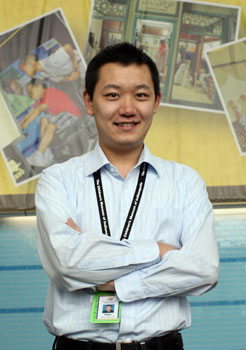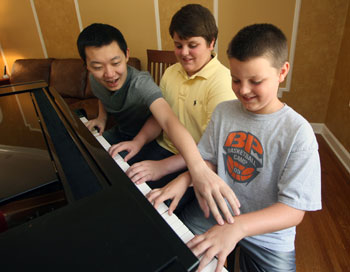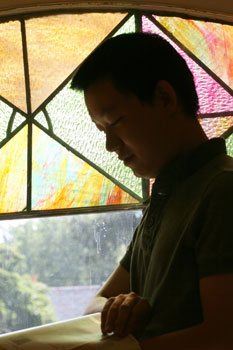Works in Progress: Snapshot from an American Dreamby Steve Charles |
| Printer-friendly version | Email this article |
|
He’s a classically trained musician, but he enjoyed playing Guitar Hero with alumnus Bob and Mary Jo Wright’s sons, Thomas and Jonathan, during his stay with the family this summer. He began his career at Wabash in economics, excelled, but chose to major in art. He believes art and marketing are not only compatible, but complementary. He claims to improvise poorly on piano, but admits, “I don’t always play what the composer wanted but what my experiences and feelings tell me.” He’s self-effacing and respectful in conversation, but brash and savvy enough to have created and sent to admissions a four-color “viewbook” of himself when he applied to Wabash. He paints, speaks his native Mandarin Chinese, fluent English, and is learning French this year, studying in the same city in which his favorite composer, Frederic Chopin, enjoyed his most creative years. This spring he’ll perform a recital of Chopin’s works. He says the pieces are performance-ready, but he wonders if his experiences in France will reshape the way he plays them. Comfortable with contradictions, mind-ful of mystery, and more interested in questions than answers, the Shenyang, China native has found a good academic fit at Wabash. And standing with Tian Tian with a visitor’s badge on your pocket and surrounded by first-graders at The Indianapolis Children’s Museum’s Science Port on an early summer afternoon, you can’t help believing this was the perfect place for him to intern as a graphic artist. Tian’s supervisor, Science Port Coordinator Rosemary Loftis, agrees. “He’s been wonderful and tackled every project we put in front of him,” she says as the kids stream out the door after their lesson. “Really—there was nothing he wouldn’t try or couldn’t do.” That’s a lot of confidence to place in an intern. Tian calls the experience “my introduction to the professional real world.” His initiation began the day after orientation, when he was told to come up with two designs for the museum’s new second-floor “Green Wind Terrace.” He started working on the project at 8:30 that morning, and at 1:10 p.m. accompanied his boss to a meeting, where Tian discovered he’d be presenting his designs to the museum’s executives. No problem. “I have always been comfortable about public speaking, especially when the people are sitting around a table,” he says. “I am comfortable working on a tight deadline, too.” He’s been designing posters and other presentations for the College’s Media Center since he arrived at Wabash, where he was mentored by then-director Jeana Rogers. “I think I picked up a lot of language and design and computer skills working there. But my boss at the museum pushed me pretty hard and I enjoyed that. That’s how you get better, find out what you can really do.” By the time his internship ended in July, Tian had designed or contributed to eight projects, including an innovative touch screen in the Science Port education center and 12 exhibition boards marking the five-year anniversary of the museum’s Dinosphere. And spending almost half of his time working with kids and their families on the museum floor taught him better ways to engage his audience through both design and presentation.
“This internship makes me realize how far I can go either in graphic design or in public relations and marketing, and I’m interested in all those areas,” says Tian. In fact, he’s hoping to work as a marketing intern next year. The barrier many artists erect between promotion and art has faded in recent years for the painter and pianist, who began his art training even earlier than his music lessons and credits Professor of Art Greg Huebner with refining his skills and expanding his vision. “But my economics background at Wabash has helped me to think both as an artist and in a way that understands the market,” he says. “I think this dual perspective will affect my eventual career choice. I really wish to integrate art skills with real-life marketing skills to make it. “I used to be more conservative about this, but right now I’m more comfortable with people promoting themselves and doing it well, as long as it doesn’t affect the work. That’s how an artist can reach and influence the general public.” Tian will reach a public of his own next April in the College’s Salter Hall when he presents a recital of 14 works by Chopin in celebration of the 200th anniversary of the Romantic-era master pianist’s birth. “Chopin has been my life’s passion,” says Tian, whose mother sang opera professionally in China. “Piano is a catalyst for my life, keeps me energetic, leads me spiritually.” He brought that energy and spirit to the grand piano at Bob and Mary Jo Wright’s Arts and Crafts-style home in Indianapolis, which became a catalyst for the Wright’s sons, as well. A member of the College’s Tau Kappa Epsilon, Tian came to stay with the Wrights after his fraternity advisor, Jon Pactor ’71, learned of his internship in Indianapolis. Pactor contacted Wright, an attorney in the city, who called his soon-to-be houseguest during final exam week. “He said, ‘Tian, I’m Bob, and I’ve been talking with Jon Pactor. Would you like to stay with us?’ He’d never even met me, and he was willing to do this for me.” An only child, Tian relished having two younger “brothers,” teaching them the Chinese language and piano, while they introduced him to Guitar Hero. Badminton games in the backyard became regular nightly fare, as were late-night piano serenades as Tian practiced. “After dinner, it was comfortable as sitting down and talking with a good friend,” Bob Wright recalls of his many evening conversations with Tian. Among the highlights of Tian’s stay was a video conversation on Skype between Mary Jo and Tian’s mother in China. “I think it made Tian’s mom feel better to see Mary Jo, two mothers talking about their sons,” Bob says. Tian smiles when he talks about this summer in Indianapolis, a town with a fraction of the population of his hometown and its seven million inhabitants. “I told Mary Jo, ‘You really make me feel as if I’m back at home.’ “I consider my stay with the Wrights and my internship a comprehensive experience. At the museum, I worked very hard to prove myself, and at night I felt like I had come home.” The sacred place Tian found in India-napolis was not at The Children’s Museum, nor at the Wright’s piano, nor in the kitchen where he baked Belgian pastries for his host family and “loved” Mary Jo’s cooking. On this warm mid-summer afternoon he leads you to the second-floor landing, where sunlight streams in like a kaleidoscope through a floor-length stained glass window and reflects off the hardwood floor, warming everything from beneath.
Tian calls himself “agnostic,” while believing that an “untouchable, superior power” exists in the world. Most of his understanding of Western religions comes from his studies of Western art and music, which he says are “inseparable” from the faith that inspired them. “I have observed some of my friends in the States achieve mental strength and well-being by praying to God, whereas I get mine from music and art. “I’d guess you could call me a ‘piano-artistian,” he jokes. But he says there is something “awe-inspiring and sacred” about this room in the Wright’s home. “There’s the stained glass, which I associate with the church. But here I think it’s more about the sunshine, how it reminds me of the welcome I feel from Bob and his family.” He shares a quote in Mandarin which sums up his philosophy of life thus far—words which roughly translate: “A miracle is something too grand for me to achieve, but a myth or a legend—something more romantic and mysterious—is the goal of my life.” “I love sitting here to read and to study, because I can see through the windows to the bench in front of the house, and watch the two boys playing on the grass with their dog, Katy,” he says. “This shapes my understanding of the American dream, and being here, I feel warmth, protection, and a sense of belonging.”
|

 Wabash junior Tian Tian says he’s not a religious man, but he found a sacred place in Indianapolis.
Wabash junior Tian Tian says he’s not a religious man, but he found a sacred place in Indianapolis.
